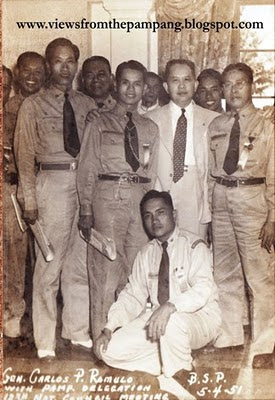 PAMPANGA COUNCIL DELEGATION. Pampanga Boy Scout officials meet Gen Carlos P. Romulo at the 12th National Council Meeting of the BSP. Dated 4 May 1951.
PAMPANGA COUNCIL DELEGATION. Pampanga Boy Scout officials meet Gen Carlos P. Romulo at the 12th National Council Meeting of the BSP. Dated 4 May 1951.I first came to know about boy scouts when I was in fifth grade. A group of older boys in khaki shorts, white T-shirts and neckerchiefs assembled in the school quadrangle one day, where they took over the raising of our flag in our daily flag ceremony. I was not only intrigued at how smart they looked, but also how efficiently they moved, each pull of the rope synchronized and measured, with the rest of the boys standing in rapt attention, right hand over their chest.
A classmate behind me wisecracked, “Boy Scouts of the Philippines, laging handa sa pagkain..”, a lampoon on the scouts' oath "Be Prepared". Whatever, these scouts became the object of my mixed admiration and envy, because I knew I could never be one of them—I had such a sickly constitution as child. Besides, my over-protective parents would not allow me to join any out-of-home activity—and what is scouting without camping?
It was in 1923 that scouting was introduced to the Philippines, by way of the establishment of the Philippine Council, chartered by the Boy Scouts of America. We became an independent scouting nation in 1936, with the Philippine Council evolving into the Boy Scouts of the Philippines—Mga Batang Lalaking Iskawt ng Pilipinas. Its mission was to imbue in the youth the love of God, country and fellowmen, transforming them into responsible leaders who can contribute to nation-building. Four years later, the Girl Scouts would be founded.
Scouting for Kapampangan boys adhered to the guidebooks outlined by the B.S.P., which in turn were patterned after America’s. The young recruit begins his membership as a Tenderfoot, where he is educated about Boy Scout basics: the Oath, Law, Motto, Slogan; the badge and the uniform; the sign, salute and the handclasp; the patrol and troop emergencies. A major part of his learning includes the ceremonials and protocols involving the Philippine flag. He is also expected to learn First Aid, various knots and how to tie them and conservation of nature.
He then graduates to the next level—the Second Class Scout. He is prepared to undergo more rigorous training—from hiking, cooking in the open as well as map-reading. Along the way, the hardy Boy Scout is expected to earn merit badges as symbols of competence and skill.
Through the years, Kapampangan Boy Scouts have earned the respect of national scouting officials by garnering awards for heroism in saving or attempting to save a life, requiring courage, a profound sense of duty and the application of his Scout training. The National Court of Honor has given such awards to several elite scouts of the Pampanga Council like Francisco Bondoc, who, in 1938, became the first Kapampangan scout to win a Bronze Medal of Honor. Luisito Bituin (1951) and Ramon Montemayor (1967) were the other Bronze awardees.
The Gold Medal of Honor has been won twice by Kapampangan scouts led by Ric Calma in 1983 and Premy Punsalan in 1984, which was awarded posthumously.
The role of scouting in developing good citizenry have always been recognized by Pampanga leaders since the country hosted the 10th World Scout Jamboree in 1959, held in Mount Makiling, Los Baños, Laguna—the first for Asia. Boy Scouts from Pampanga and American Scouts from Clark joined 12,000 scouts from all over the world, and for five days, mingled, socialized and learned Philippine culture—including eating carabao meat and green coconuts.
During the tenure of Gov. Cielo Macapagal-Salgado, a camping site for Boy and Girl Scouts was established in Magalang. Recently in March 2010, the Boy Scouts of the Philippines cited Angeles City Mayor Francis “Blueboy” Nepomuceno together with Councilor Ric Zalamea and School Division Superintendent Antonieta Tiotuico for rendering praiseworthy service and support to the scouting movement. Nepomuceno, who was awarded a “Silver Usa” (Silver Deer), said the city gets its inspiration form the Boy Scouts—always prepared in times of calamity and crisis, relying on foresight and effective planning to deter the effects of an impending disaster.
It was not too long ago too that Clark Field became the venue for the 11th Boy Scouts of the Philippines National Jamboree which coincided with the Philippine Independence Centennial. The Philippine Centennial Scout Jamboree, as it was dubbed, was held at the former Picnic Grounds and Equestrian Field of former military base, from January 5-11, 1998. Thirty four thousand scouts and officials descended to the 40 hectare camp site, depositing trash, overfilling septic tanks and filling the air with flies and fetid odor. In turn, the participants complained and bickered about the lack of food, transportation and inadequate facilities. Nothing is perfect in this world, but as model scouts, they should have been more prepared--"laging handa" for anything.








No comments:
Post a Comment